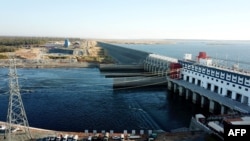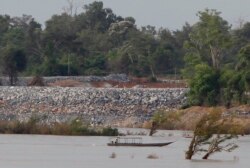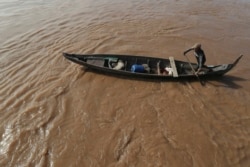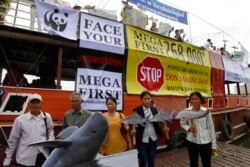Experts in Cambodia have welcomed the government's recent halt on hydropower development on the Mekong River until 2030, but called on the government to focus on renewable energies.
The spokesman for the Ministry of Mines and Energy's General Department, Victor Jona, told VOA on Tuesday that no further hydropower dams were needed on the Mekong River main stream for the next 10 years to meet energy demand.
"From 2020 to 2030, there will not be any developments of hydropower on the main river," he said.
The announcement effectively pauses the development of the two planned dams, Sambor and Stung Treng.
Other tributaries, however, are excluded from this halt. For example, an 80 megawatt plant in Stung Pursat Province was still on the table, Victor Jona said. The government also did not exclude the possibility of further hydropower projects on the river after 2030.
Environmentalists warn that hydropower dams have disastrous consequences for rivers' ecological systems. The Mekong River is one of the biggest rivers in the region and thousands of families depend on it for livelihoods.
The decision to pause the dams' development has given the government time to invest in other energy sources, experts said.
"This announcement is excellent news for people in Cambodia, Vietnam and the wider region," said Maureen Harris, Director of Programs at International Rivers. "The proposed Sambor and Stung Treng dams are predicted to have devastating impacts on Mekong fisheries and floodplains, and would likely deliver a death blow to the Mekong delta, which is already under immense pressure from the combined impacts of climate change and existing dams upstream in China and Laos."
'Risks outweigh benefits'
The electricity generated by existing dams, she added, had raised questions of whether hydropower dams were able to produce the energy they had promised.
Brian Eyler, Southeast Asia program director at the Stimson Center, echoed the assessment.
"The announcement … is a clear signal that mainstream Mekong dams are becoming outdated and under-performing options for power generation," he told VOA via email.
He said this sent a message to Laos and investors in the neighboring state "that Mekong mainstream dams make poor economic, environmental, and political sense."
Most prominently, Laos is expected to begin construction of the Luang Prabang dam later this year. This, observers say, threatens the ecosystem of downstream Mekong.
Eyler said that record low river levels over the last two years had caused electricity blackouts in the country for several months as there was not enough water to turn the turbines.
"Clearly the risks to mainstream Mekong dams outweigh the benefits in the eyes of Cambodia's leaders," he said.
One of those risks, he said, was the threat it posed to the fish stock. "The two mainstream dams at Stung Treng and Sambor would have … effectively killed the Mekong's fish population," he said.
Energy needs
But Victor Jona said the government had re-evaluated their energy master plan based on research that they had commissioned in 2019 that did not include environmental factors. Finalized in February, the research looked at population-, industrial-, and demand growth, and found that energy demands were largely covered by other sources, he said. One new source included increased energy imports from Laos: While previously Cambodia had bought less than 50 megawatts from Laos' recently opened Dor Sahong dam, it now had ordered 195 additional megawatts, he said.
A study currently conducted by Asia Development Bank is analyzing Cambodia's energy needs for the next 20 years. While it included additional factors such as changes in energy efficiency in the country, the study also did not look at environmental factors, he said. The study is expected to be finalized next year.
To cover electricity needs, the Cambodian government would also extend its coal-fired electricity production, he said.
The National Assembly last week approved two new coal-fired electricity plants amounting to 900 megawatts combined.
But Courtney Weatherby, a research analyst at the Stimson Center who focuses on energy, sustainability and water, said that coal was not an immediate answer to Cambodia's electricity needs, as it often took years to build the plants.
Compared to hydropower, she said, it did have advantages: New hydropower and coal plants both sold electricity at about 7 cents per kilowatt-hour, she said, but because coal is not as vulnerable to drought as hydropower, it is more reliable.
Yet, this could have long-term negative effects.
"Coal has environmental impacts," she said. "In the long-term, coal generates carbon emissions that contribute to climate change."
Thus, instead of focusing on coal or hydropower, the government should focus more extensively on renewable energies, Weatherby said.
Victor Jona agreed that Cambodia had the potential to develop solar energy further. Going forward, Jona said, Cambodia would increase its capacity for solar energy. Currently it constituted less than 10 percent of Cambodia's energy mix, and hydropower 36 percent, but the government had already approved plans for 300 additional megawatts. And from 2021 onward, an additional 200 megawatts would be integrated into Cambodia's electricity net every year.
Weatherby said Cambodia had an estimated potential of 8,000 megawatts generated by solar energy, and 6,500 megawatts by wind turbines. Although the full potential was unlikely to be reached, she said solar projects could be built more quickly to address electricity shortages.
"Solar energy in particular is a very viable option for Cambodia's future electricity generation," she said.











